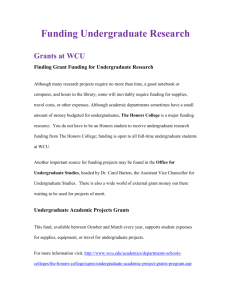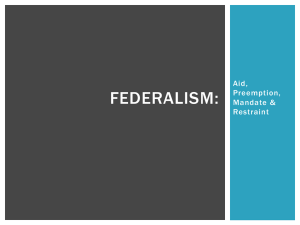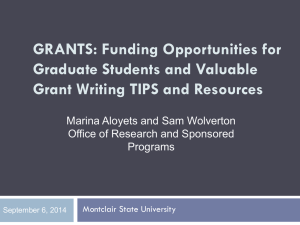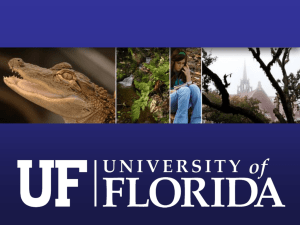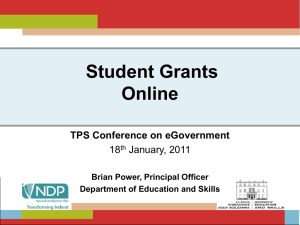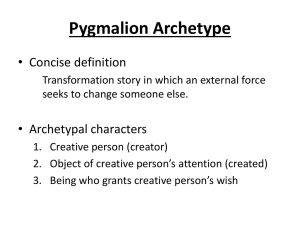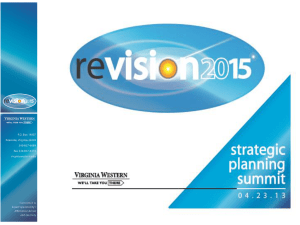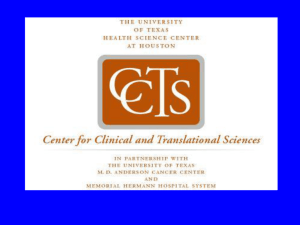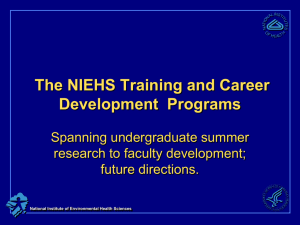Demystifying the U.S. Department of Education
advertisement
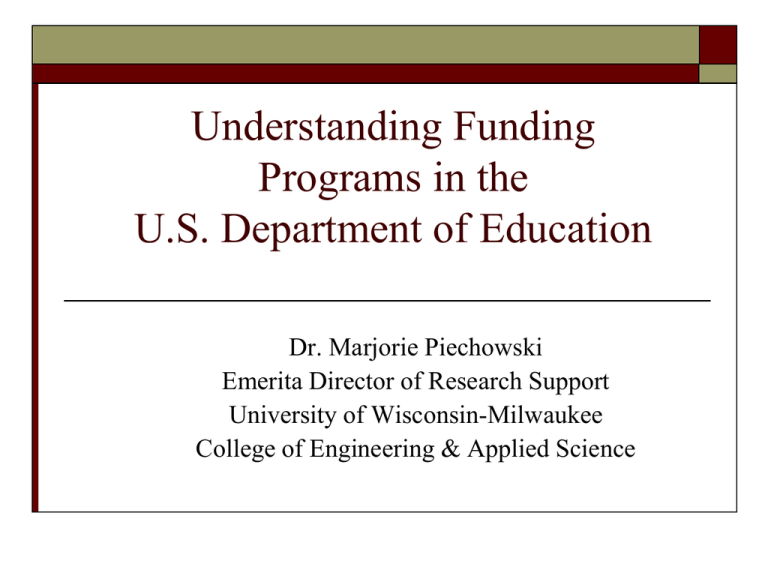
Understanding Funding Programs in the U.S. Department of Education Dr. Marjorie Piechowski Emerita Director of Research Support University of Wisconsin-Milwaukee College of Engineering & Applied Science Your Presenter: Dr. Marjorie Piechowski 30 years as research administrator at three major universities, mentoring faculty and facilitating faculty grant applications and awards in all disciplines Past president of Society of Research Administrators International (SRA) SRA Distinguished Faculty SRA Excellence Award National Organization of Research Development Professionals Board Member Editorial board of Journal of Research Administration Principal grant writer of $22+ million of successful ED and other federal grants for many universities ED reviewer since 1994 Overview and Learning Objectives Understand the purpose and structure of the U.S. Department of Education (ED) Learn about the many ED grant programs available to higher education and how to find these programs Gain information about ED program officers, their role and relationship with applicants Become familiar with the ED proposal format, review process and scoring system ED Quick Facts and why they matter ED a mission agency, not a research or academic agency ED funds projects that improve education at all levels, from early childhood to graduate ED not discipline-specific to education ED also collects and analyzes data ED subject to politics in many ways ED a relatively new federal agency: 1980 ED Organization Chart Note divisions and subdivisions: Office of … White House Initiatives on … Institute of … Pink boxes = grant programs Other boxes = administrative Except Institute of Education, a new research component of ED ED and the Budget ED’s budget is allocated in two ways: Formula grants Recipients: states, municipalities, local school systems, tribes, higher education (student financial aid) Discretionary grants *** $71 billion in 2014 Recipients: individuals and institutions (higher education, secondary and elementary education, community organizations, faith-based organizations, tribes, etc.) ED and Your Institution Many relevant programs available for higher education Institutional grants Program grants Group grants Individual-led project grants Research Programs Re-grants Office of Postsecondary Education (OPE) OPE both formulates policy for higher education and administers grant programs Higher Education Preparation and Support Service administers eight TRIO outreach and support programs to help disadvantaged students progress from middle school to postbaccalaureate programs, and programs related to preparation for postsecondary education. Upward Bound, Talent Search, Student Support Services, McNair, etc. --well established at many institutions Target population: first-generation, low-income college students and low student expenditures OPE: Institutional Development and Undergraduate Education Programs (IDUES) IDUES administers Title III, Strengthening Institution Programs, to help higher education institutions that serve a large proportion of disadvantaged students improve their academic programs and administrative capabilities. Title V, Developing Hispanic-Serving Institutions Program- assist eligible Hispanic-serving institutions of higher education to expand their capacity to serve Hispanic and low-income students. Undergraduate incentive programs Title III Programs, continued… Separate programs for special populations: American Indian Tribally Controlled Colleges and Universities Alaska Native and Native Hawaiian-Serving Institutions Asian-American and Native American Pacific IslanderServing Institutions Native American-Serving Nontribal Institutions Historically Black Colleges and Universities Predominantly Black Institutions--new program Minority Science and Engineering Improvement OPE: International Education Programs Title VI (HEA) domestic international education programs, and programs authorized by the FulbrightHays Act. strengthen the capability and performance of American education in foreign languages and in area and international studies. Overseas programs are intended to improve secondary and postsecondary teaching and research concerning other cultures and languages, training of specialists, and the American public's general understanding of the peoples of other countries. International Education Grants (BIE) BIE did not hold grant competitions in FY 2011, FY 2012, or FY 2013 but several programs will have 2014 deadlines American Overseas Research Centers Business and International Education Improving the business and international education curriculum of institutions to serve the needs of the business community, including the development of new programs for mid-career or part-time students; Developing programs to inform the public of increasing international economic interdependence and the role of U.S. businesses within the international economic system; Internationalizing curricula at the junior and community college level and at undergraduate and graduate schools of business; More International Education Grants Developing area studies and interdisciplinary international programs; Establishing export education programs; Conducting research and developing specialized teaching materials appropriate to business-oriented students; Establishing student and faculty fellowships and internships or other training or research opportunities; Creating opportunities for business and professional faculty to strengthen international skills; Business and International Education Developing research programs on issues of common interest to IHEs and private sector organizations and associations engaged in or promoting international economic activity; Establishing internships overseas to enable foreign language students to develop their foreign language skills and knowledge of foreign cultures and societies; Establishing links overseas with IHEs and organizations that contribute to the education objectives of this program; and Establishing summer institutes in international business, foreign areas, and other international studies designed to carry out the purposes of this program. Business and International Education Centers for International Business Education funds business schools for curriculum development, research, and training on issues of importance to U.S. trade and competitiveness. Foreign Language and Area Studies Fellowships (FLAS) academic year and summer fellowships to institutions of higher education or consortia of institutions of higher education to assist meritorious undergraduate students and graduate students undergoing training in modern foreign languages and related area or international studies. Business and International Education Each fellowship includes subsistence allowance and institutional payment: Subsistence allowance 2010-2011 (most recent): $15,000 graduate student, $5,000 undergraduate Summer: $2,500 graduate and undergraduate Institutional payment 2010-2011(most recent): $18,000 graduate student, $10,000 undergraduate Summer: $5,000 graduate and undergraduate Business and International Education Fulbright-Hays Training Grants--Doctoral Dissertation Research Abroad Fulbright-Hays Seminars Abroad—Bilateral Projects Fulbright-Hays Training Grants--Faculty Research Abroad Business and International Education Fulbright-Hays Training Grants—Group Projects Abroad overseas projects in training, research, and curriculum development in modern foreign languages and area studies for teachers, students, and faculty engaged in a common endeavor. short-term seminars, curriculum development, group research or study, or advanced intensive language programs. Projects must focus on the humanities, social sciences and languages and on one or more of the following areas: Africa, East Asia, South Asia, Southeast Asia and the Pacific, the Western Hemisphere (Central and South America, Mexico, and the Caribbean), East Central Europe and Eurasia, and the Near East. Business and International Education Institute for International Public Policy International Research and Studies Language Resource Centers National Resource Centers Technological Innovation/Cooperation for Foreign Information Access Undergraduate International Studies and Foreign Language Program Teacher and Student Development Planning, policy development, and grant administration functions for teacher preparation programs, graduate fellowship programs, early intervention programs, and minority-serving institutions programs. Teacher Preparation Programs Teachers for a Competitive Tomorrow Teacher Quality Enhancement Grants for States and Partnerships Demonstration Projects to Ensure Students with Disabilities Receive a Quality Higher Education Teacher and Student Development Graduate Assistance in Areas of National Need (GAANN) – last competition held in 2012 ED decides the eligible academic areas: previous: Area Studies Biology/Life Sciences, Chemistry, Physics, Mathematics Computer and Information Sciences, Engineering Foreign Languages and Literature Nursing Educational Assessment, Evaluation and Research Teacher and Student Development Graduate Fellowships Programs, continued… Institution/ department application $30,000 annual fellowships for each student plus expenses: tuition, travel, supplies 5 or more fellows required per grant Strong faculty research involvement U.S. citizenship required 5-year grants Required cost-sharing and institutional support Office of Special Education and Rehabilitative Services (OSERS) Goal: improving results and outcomes for people with disabilities of all ages. Wide array of support to parents and individuals, school districts and states in three main areas: special education vocational rehabilitation research National Institute on Disability and Rehabilitation Research (NIDRR) Comprehensive and coordinated programs of research and related activities to assist in the achievement of the full inclusion, social integration, employment and independent living of people with disabilities. Funding categories include: Rehabilitation Research and Training Centers Rehabilitation Engineering Research Centers NIDDR Scholars Program National Institute on Disability and Rehabilitation Research (NIDRR)… Disability and Rehabilitation Research Projects Field-Initiated Projects Advanced Rehabilitation Research Training Projects Mary E. Switzer Fellowships Small Business Innovation Research Model Systems of Care Office of English Language Acquisition (OELA) Foreign Language Assistance Program Funds Local Educational Agencies (LEA) with Institutions of Higher Education (IHE) Innovative model programs providing for the establishment, improvement, or expansion of foreign language study for elementary and secondary school students into and through college 5-year grants, $200k average per year Goal: more students become competent in English and in other languages Institute of Education Sciences (IES) Organizational Structure Office of the Director National Center for Education Research ies.ed.gov National Center for Education Statistics National Board for Education Sciences National Center for Education Evaluation 3 National Center for Special Education Research Institute of Education Sciences (IES) New unit, modeled on NIH applications and reviews Research arm of ED grant programs Examples of competitive research programs: Education Research Programs Special Education Research Programs Statistical and Research Methodology in Education Special Education Initiative: Accelerating Academic Achievement of Students with Learning Disabilities Evaluation of State and Local Education Programs Researcher-Practitioner Partnerships in Research and…Unsolicited Grant Opportunities Institute of Education Sciences (IES) Research Training Programs: Postdoctoral Training Program in the Education Sciences Researcher and Policymaker Training Program in the Education Sciences Research Training Program in Special Education: Early Career Development and Mentoring Program So how do you apply for ED grants? ED Proposal Process Federal Register announcement Long, legalistic, detailed RFP based on federal statutes and authorizing legislation Application materials and full program announcement downloaded from grants.gov Few established application dates—but see next slide Competitions may be annual or sporadic Minimum 30-day notice required Electronic submission process: grants.gov or ED’s own e-grants system Upcoming Ed Deadlines New feature on Ed web page: January 31, 2014 Forecast of Funding Opportunities of ED Discretionary Grant Programs for FY 2014 Chart 1: Institute of Education Sciences Chart 2: Office of Elementary and Secondary Education Chart 3: Office of Innovation and Improvement Chart 4: Office of Postsecondary Education Chart 5: Office of Special Education and Rehabilitative Services Chart 6: Office of the Deputy Secretary Contents of Charts CFDA Number and Program Name Application notice name and number Link to application notice (pdf or text) Application deadline (many have N/A or TBD) Deadline for intergovernmental review Estimated average size and number of awards Program contact person (name, e-mail, fax, telephone number) Ed Program Officers: My Observations Tend to be career government employees rather than disciplinary experts Move from ED program to ED program or from other government agencies May handle multiple ED programs Responsible for choosing reviewers and managing review process May be difficult to reach; generally do not provide advice on proposal development ED Proposal Development Typical Proposal Components: 100 total points Meeting the authorizing legislation/Need for project Objectives Quality of project design Quality of project personnel** Quality of management plan Quality of project evaluation Adequacy of resources (budget and budget narrative included as part of proposal narrative)** Overview of ED Review Process Applicant receives three reviews with individual scores and comments plus summary score Award notice may first go to politicians Cover letter indicates total score, cut-off score for awards, and funding decision Awards made in numerical order, starting at 100 + more Ties broken by announced formulas or other unannounced factors (award amount, geography, politics, demographics, grant history of project or institution, focus of project activities, project director) ED Reviewers Chosen by ED program officers from ED database Each reviewer reads up to 10 proposals, usually over three to five working days, usually at home Usually paid $100/proposal + $100 for copying Some panels also meet in Washington, D.C. Total possible score of 100 points (or more) Each required section has a specific point value Each reviewer separately scores each proposal read Program officer holds panel discussion to reconcile deviations in scores for each section and total points Each reviewer must fill in something for both strengths and weaknesses even for perfect scores Becoming a Reviewer for ED Programs Ph.D. not a requirement but Relevant education and professional experience Upload CV into ED database From pull-down menu, select programs to review and give brief reason for selection Agree to sign conflict of interest and confidentiality agreements Be willing and able to devote one or two full weeks to review Final Thoughts ED has an amazing array of grant programs for many academic disciplines except STEM President wants ED to coordinate STEM education with other federal grant agencies ED grants are very different from other federal grant applications in proposal format, application process, review process..but ED grants can make a major difference for faculty and higher education in general For Questions and Follow-up: Dr. Marjorie Piechowski marjorie.piechowsk@sbcglobal.net 414-963-9055
